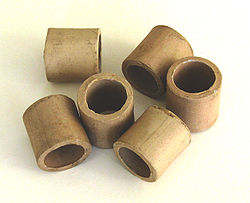Informatics Educational Institutions & Programs
Contents

Specific surface area (SSA) is a property of solids defined as the total surface area (SA) of a material per unit mass,[1] (with units of m2/kg or m2/g). Alternatively, it may be defined as SA per solid or bulk volume[2][3] (units of m2/m3 or m−1).
It is a physical value that can be used to determine the type and properties of a material (e.g. soil or snow). It has a particular importance for adsorption, heterogeneous catalysis, and reactions on surfaces.
Measurement


Values obtained for specific surface area depend on the method of measurement. In adsorption based methods, the size of the adsorbate molecule (the probe molecule), the exposed crystallographic planes at the surface and measurement temperature all affect the obtained specific surface area.[4] For this reason, in addition to the most commonly used Brunauer–Emmett–Teller (N2-BET) adsorption method, several techniques have been developed to measure the specific surface area of particulate materials at ambient temperatures and at controllable scales, including methylene blue (MB) staining, ethylene glycol monoethyl ether (EGME) adsorption,[5] electrokinetic analysis of complex-ion adsorption[4] and a Protein Retention (PR) method.[6] A number of international standards exist for the measurement of specific surface area, including ISO standard 9277.[7]
Calculation
The SSA can be simply calculated from a particle size distribution, making some assumption about the particle shape. This method, however, fails to account for surface associated with the surface texture of the particles.
Adsorption
The SSA can be measured by adsorption using the BET isotherm. This has the advantage of measuring the surface of fine structures and deep texture on the particles. However, the results can differ markedly depending on the substance adsorbed. The BET theory has inherent limitations but has the advantage to be simple and to yield adequate relative answers when the solids are chemically similar. In relatively rare cases, more complicated models based on thermodynamic approaches, or even quantum chemistry, may be applied to improve the consistency of the results, but at the cost of much more complex calculations requiring advanced knowledge and a good understanding from the operator.[8]
Gas permeability
This depends upon a relationship between the specific surface area and the resistance to gas-flow of a porous bed of powder. The method is simple and quick, and yields a result that often correlates well with the chemical reactivity of a powder. However, it fails to measure much of the deep surface texture.
| Typical surface area (m2/g) | Material | Application |
|---|---|---|
| 7140 | Metal–organic framework[9] | gas absorption |
| 900 | Faujasite[10] | catalyst |
| 500–3000 | activated carbon | gas and solute absorption |
| 200 | alumina[11] | catalyst support |
See also
References
- ^ IUPAC, Compendium of Chemical Terminology, 2nd ed. (the "Gold Book") (1997). Online corrected version: (2006–) "specific surface area". doi:10.1351/goldbook.S05806
- ^ http://www.owlnet.rice.edu/~ceng402/Hirasaki/CHAP3D.pdf[bare URL PDF]
- ^ http://www.rsc.org/suppdata/lc/b8/b812301b/b812301b.pdf[bare URL PDF]
- ^ a b Hanaor, D.A.H.; Ghadiri, M.; Chrzanowski, W.; Gan, Y. (2014). "Scalable Surface Area Characterization by Electrokinetic Analysis of Complex Anion Adsorption" (PDF). Langmuir. 30 (50): 15143–15152. arXiv:2106.03411. doi:10.1021/la503581e. PMID 25495551. S2CID 4697498.
- ^ Cerato, A.; Lutenegger, A. (1 September 2002). "Determination of surface area of fine-grained soils by the ethylene glycol monoethyl ether (EGME) method". Geotechnical Testing Journal. 25 (3): 10035. doi:10.1520/GTJ11087J.
- ^ Paykov, O.; Hawley, H. (1 July 2013). "A Protein-Retention Method for Specific Surface Area Determination in Swelling Clays". Geotechnical Testing Journal. 36 (4). ASTM: 20120197. doi:10.1520/GTJ20120197.
- ^ "ISO 9277:2010(en) Determination of the specific surface area of solids by gas adsorption — BET method".
- ^ Condon, James (2020). Surface Area and Porosity Determinations by Physisorption, 2nd edition. Amsterdam, NL: Elsevier. pp. Chapters 3, 4 and 5. ISBN 978-0-12-818785-2.
- ^ Hönicke, Ines M.; Senkovska, Irena; Bon, Volodymyr; Baburin, Igor A.; Bönisch, Nadine; Raschke, Silvia; Evans, Jack D.; Kaskel, Stefan (2018). "Balancing Mechanical Stability and Ultrahigh Porosity in Crystalline Framework Materials". Angewandte Chemie International Edition. 57 (42): 13780–13783. doi:10.1002/anie.201808240. PMID 30160076. S2CID 52119126.
- ^ Galarneau, Anne; Mehlhorn, Dirk; Guenneau, Flavien; Coasne, Benoit; Villemot, Francois; Minoux, Delphine; Aquino, Cindy; Dath, Jean-Pierre (2018). "Specific Surface Area Determination for Microporous/Mesoporous Materials: The Case of Mesoporous FAU-Y Zeolites" (PDF). Langmuir. 34 (47): 14134–14142. doi:10.1021/acs.langmuir.8b02144. PMID 30379547. S2CID 53197261. hal-01938089.
- ^ Russell, Allen S.; Cochran, C. Norman (1950). "Alumina Surface Area Measurements". Industrial & Engineering Chemistry. 42 (7): 1332–1335. doi:10.1021/ie50487a024.

















